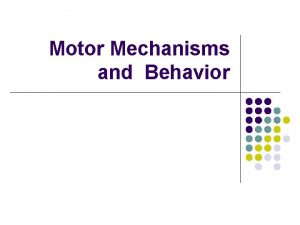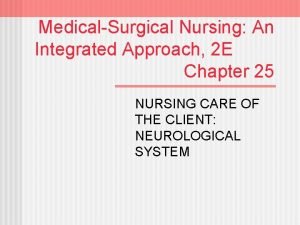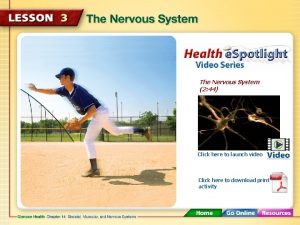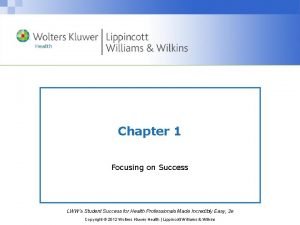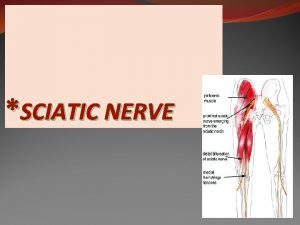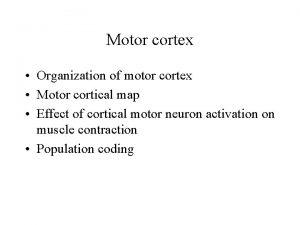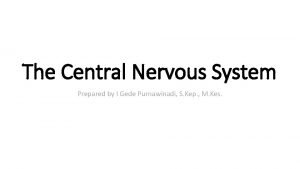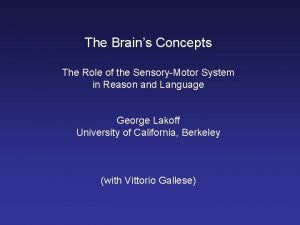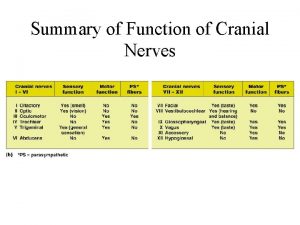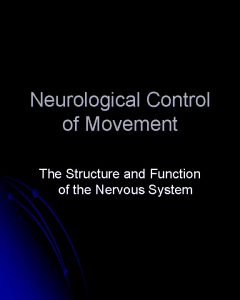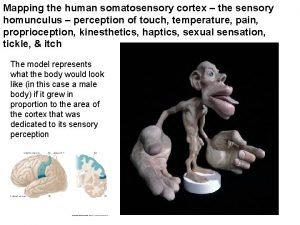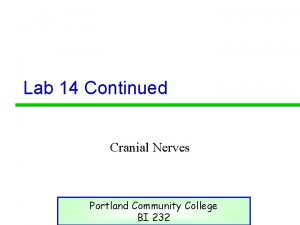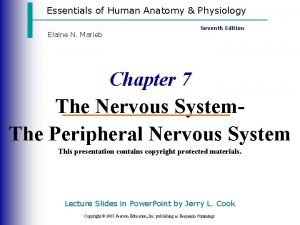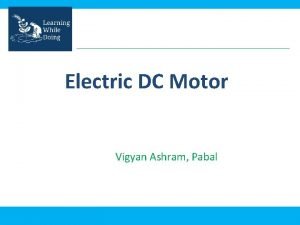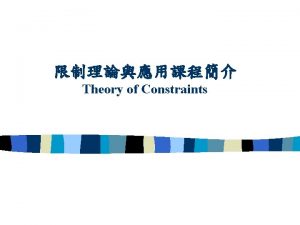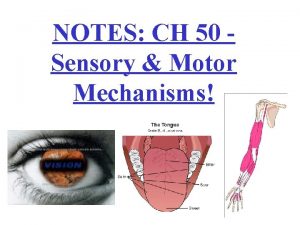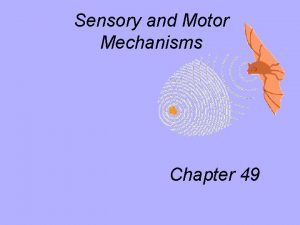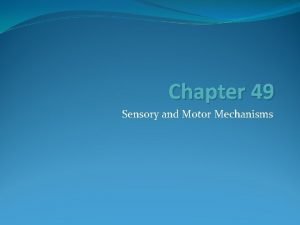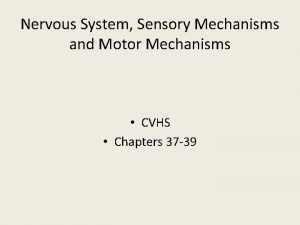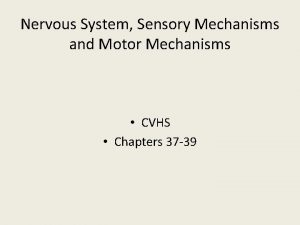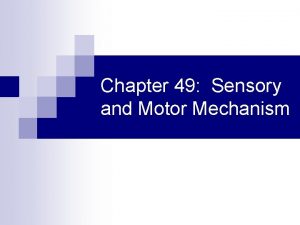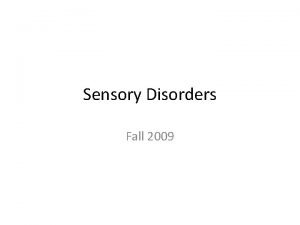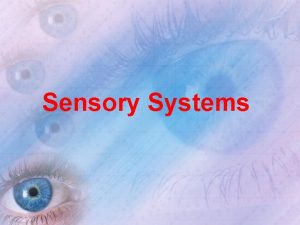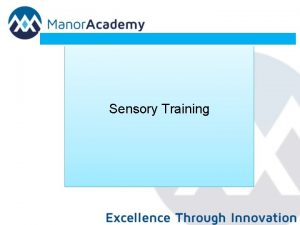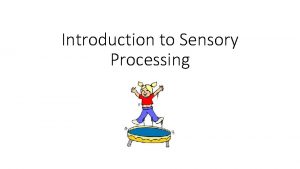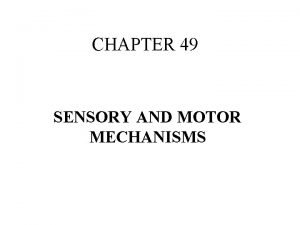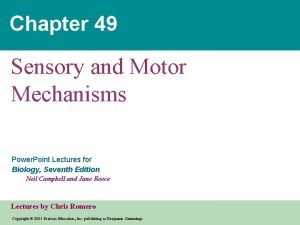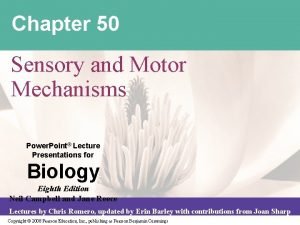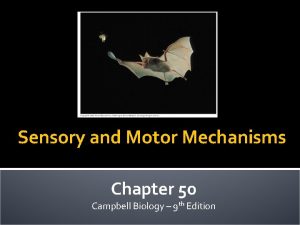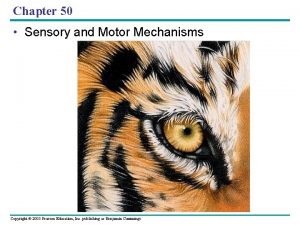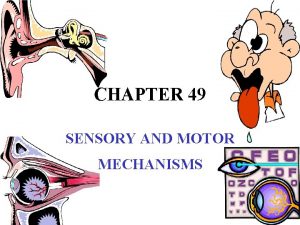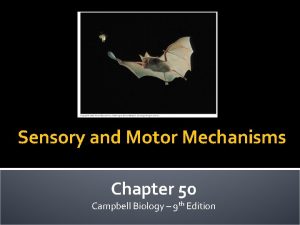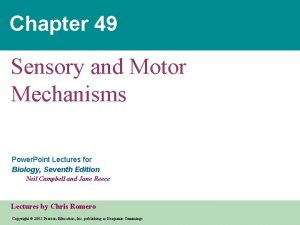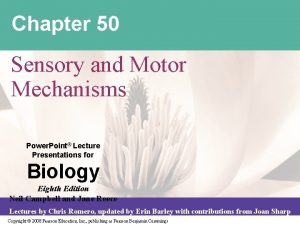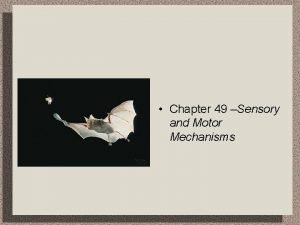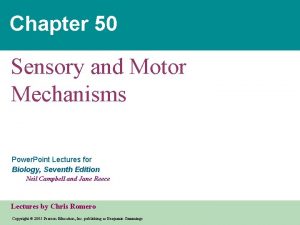Chapter 49 Sensory and Motor Mechanisms Just focusing


























- Slides: 26

____ Chapter 49 ~ Sensory and Motor Mechanisms • (Just focusing on motor mechanisms) • Motor Mechanisms

Muscle involuntary, striated auto-rhythmic voluntary, striated heart moves bone multi-nucleated evolved first involuntary, non-striated digestive system arteries, veins

Organization of Skeletal muscle skeletal muscle nuclei tendon muscle fiber (cell) myofibrils myofilaments plasma membrane

Human endoskeleton 206 bones

Muscles movement • Muscles do work by contracting – skeletal muscles come in antagonistic pairs • flexor vs. extensor – contracting = shortening • move skeletal parts – tendons • connect bone to muscle – ligaments • connect bone to bone


Structure of striated skeletal muscle • Muscle Fiber – muscle cell • divided into sections = sarcomeres • Sarcomere – functional unit of muscle contraction – alternating bands of thin (actin) & thick (myosin) protein filaments

Muscle filaments & Sarcomere • Interacting proteins – thin filaments • braided strands – actin – tropomyosin – troponin – thick filaments • myosin

Thin filaments: actin • Complex of proteins – braid of actin molecules & tropomyosin fibers • tropomyosin fibers secured with troponin molecules

Thick filaments: myosin • Single protein – myosin molecule • long protein with globular head bundle of myosin proteins: globular heads aligned

Interaction of thick & thin filaments • Cross bridges – connections formed between myosin heads (thick filaments) & actin (thin filaments) – cause the muscle to shorten (contract) sarcomere

Where is ATP needed? binding site thin filament (actin) myosin head ADP 12 thick filament (myosin) ATP So that’s where those 10, 000 ATPs go! Well, not all of it! 1 1 form cross bridge 1 3 release cross bridge Cleaving ATP ADP allows myosin head 1 to bind to actin filament shorten sarcomere 4

Closer look at muscle cell Sarcoplasmic reticulum Transverse tubules (T-tubules) multi-nucleated Mitochondrion

Ca 2+ ATPase of SR Muscle cell organelles • Sarcoplasm – muscle cell cytoplasm – contains many mitochondria • Sarcoplasmic reticulum (SR) There’s the rest of the ATPs! – organelle similar to ER • network of tubes – stores Ca 2+ • Ca 2+ released from SR through channels • Ca 2+ restored to SR by Ca 2+ pumps – pump Ca 2+ from cytosol – pumps use ATP But what does the Ca 2+ do?

Muscle at rest • Interacting proteins – at rest, troponin molecules hold tropomyosin fibers so that they cover the myosin-binding sites on actin • troponin has Ca 2+ binding sites

The Trigger: motor neurons • Motor neuron triggers muscle contraction – release acetylcholine (Ach) neurotransmitter

Ca 2+ triggers muscle action • At rest, tropomyosin blocks myosin-binding sites on actin – secured by troponin • Ca 2+ binds to troponin – shape change causes movement of troponin – releasing tropomyosin – exposes myosin-binding sites on actin

How Ca 2+ controls muscle • Sliding filament model – exposed actin binds to myosin – fibers slide past each other • ratchet system ATP – shorten muscle cell • muscle contraction – muscle doesn’t relax until Ca 2+ is pumped back into SR • requires ATP

Put it all together… 1 2 3 ATP 7 4 6 ATP 5

How it all works… • Action potential causes Ca 2+ release from SR – Ca 2+ binds to troponin • Troponin moves tropomyosin uncovering myosin binding site on actin • Myosin binds actin ATP – uses ATP to "ratchet" each time – releases, "unratchets" & binds to next actin • Myosin pulls actin chain along • Sarcomere shortens – Z discs move closer together • Whole fiber shortens contraction! • Ca 2+ pumps restore Ca 2+ to SR relaxation! – pumps use ATP

Fast twitch & slow twitch muscles • Slow twitch muscle fibers – contract slowly, but keep going for a long time • more mitochondria for aerobic respiration • less SR Ca 2+ remains in cytosol longer – long distance runner – “dark” meat = more blood vessels • Fast twitch muscle fibers – contract quickly, but get tired rapidly • store more glycogen for anaerobic respiration – sprinter – “white” meat

Muscle limits • Muscle fatigue – lack of sugar • lack of ATP to restore Ca 2+ gradient – low O 2 • lactic acid drops p. H which interferes with protein function – synaptic fatigue • loss of acetylcholine • Muscle cramps – build up of lactic acid – ATP depletion – ion imbalance • massage or stretching increases circulation

Diseases of Muscle tissue • ALS – amyotrophic lateral sclerosis – Lou Gehrig’s disease – motor neurons degenerate • Myasthenia gravis – auto-immune – antibodies to acetylcholine receptors Stephen Hawking

Botox • Bacteria Clostridium botulinum toxin – blocks release of acetylcholine – botulism can be fatal muscle

Rigor mortis § So why are dead people “stiffs”? no life, no breathing u no breathing, no O 2 u no O 2, no aerobic respiration u no aerobic respiration, no ATP u no ATP, no Ca 2+ pumps u Ca 2+ stays in muscle cytoplasm u muscle fibers continually contract u § tetany or rigor mortis u eventually tissues breakdown & relax § measure of time of death

So don’t be a stiff! Ask Questions!! 2006 -2007
 Altruisml
Altruisml Middle cranial fossa
Middle cranial fossa Sensory
Sensory Cranial nerves sensory and motor
Cranial nerves sensory and motor Sensory input and motor output
Sensory input and motor output Cranial nerves sensory and motor
Cranial nerves sensory and motor Motor and sensory nerve
Motor and sensory nerve Incoming sensory impulses and outgoing motor impulses
Incoming sensory impulses and outgoing motor impulses Chapter 1 focusing on success powerpoint
Chapter 1 focusing on success powerpoint Sciatic nerve branches
Sciatic nerve branches On old olympus towering tops a friendly viking
On old olympus towering tops a friendly viking Motor cortex sensory cortex
Motor cortex sensory cortex Sensory vs motor homunculus
Sensory vs motor homunculus Sensory-motor
Sensory-motor Classification of cranial nerves
Classification of cranial nerves Saltitory
Saltitory 45 degrees c
45 degrees c Hypoglossal nerve damage
Hypoglossal nerve damage Cranial nerve mnemonic
Cranial nerve mnemonic Which two characters are detained by the watchmen
Which two characters are detained by the watchmen A motor unit is
A motor unit is Pony motor starting method diagram
Pony motor starting method diagram Hunting in electrical machines
Hunting in electrical machines Motor parts name
Motor parts name Ee 216
Ee 216 Five focusing steps
Five focusing steps Project integration management
Project integration management
